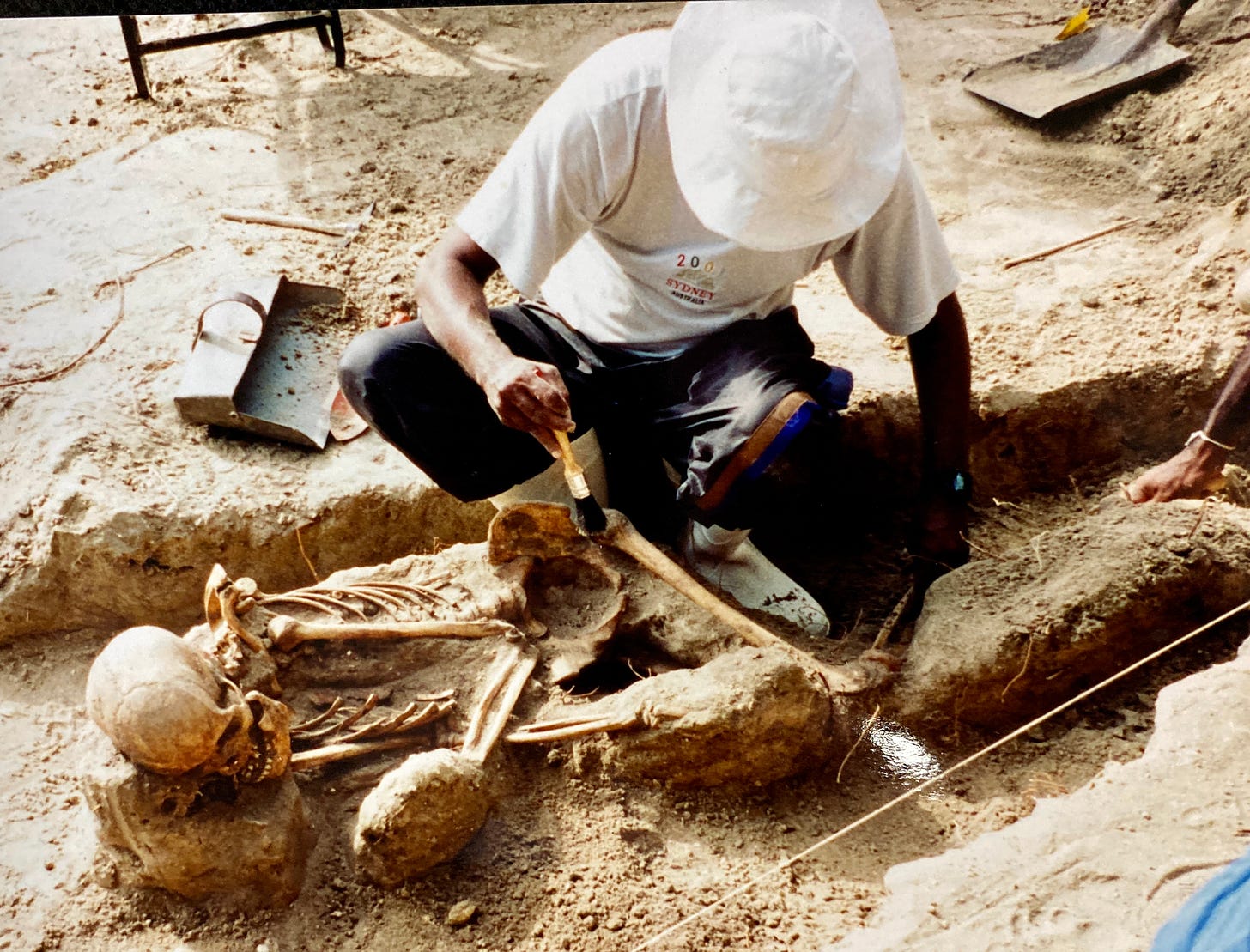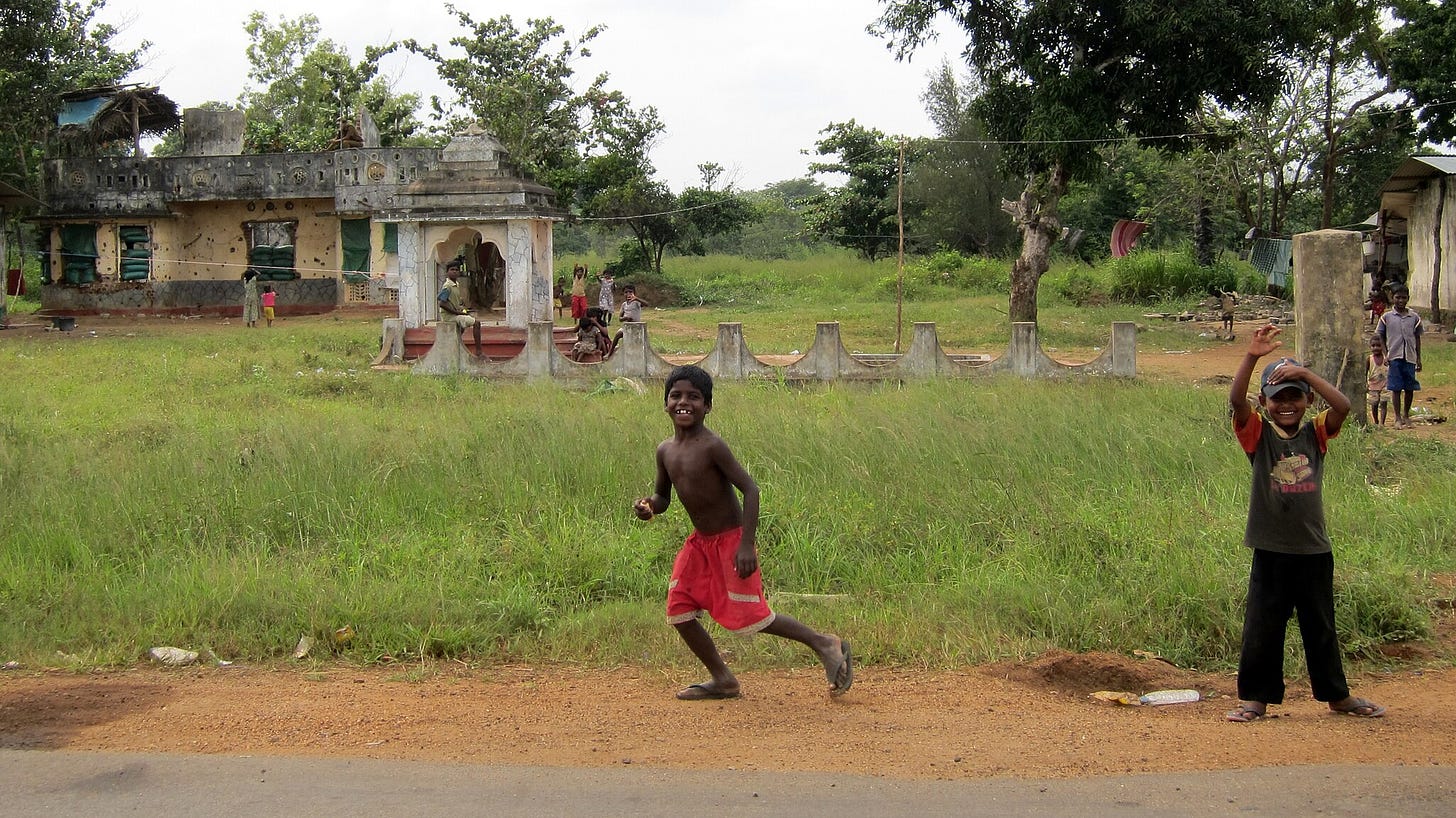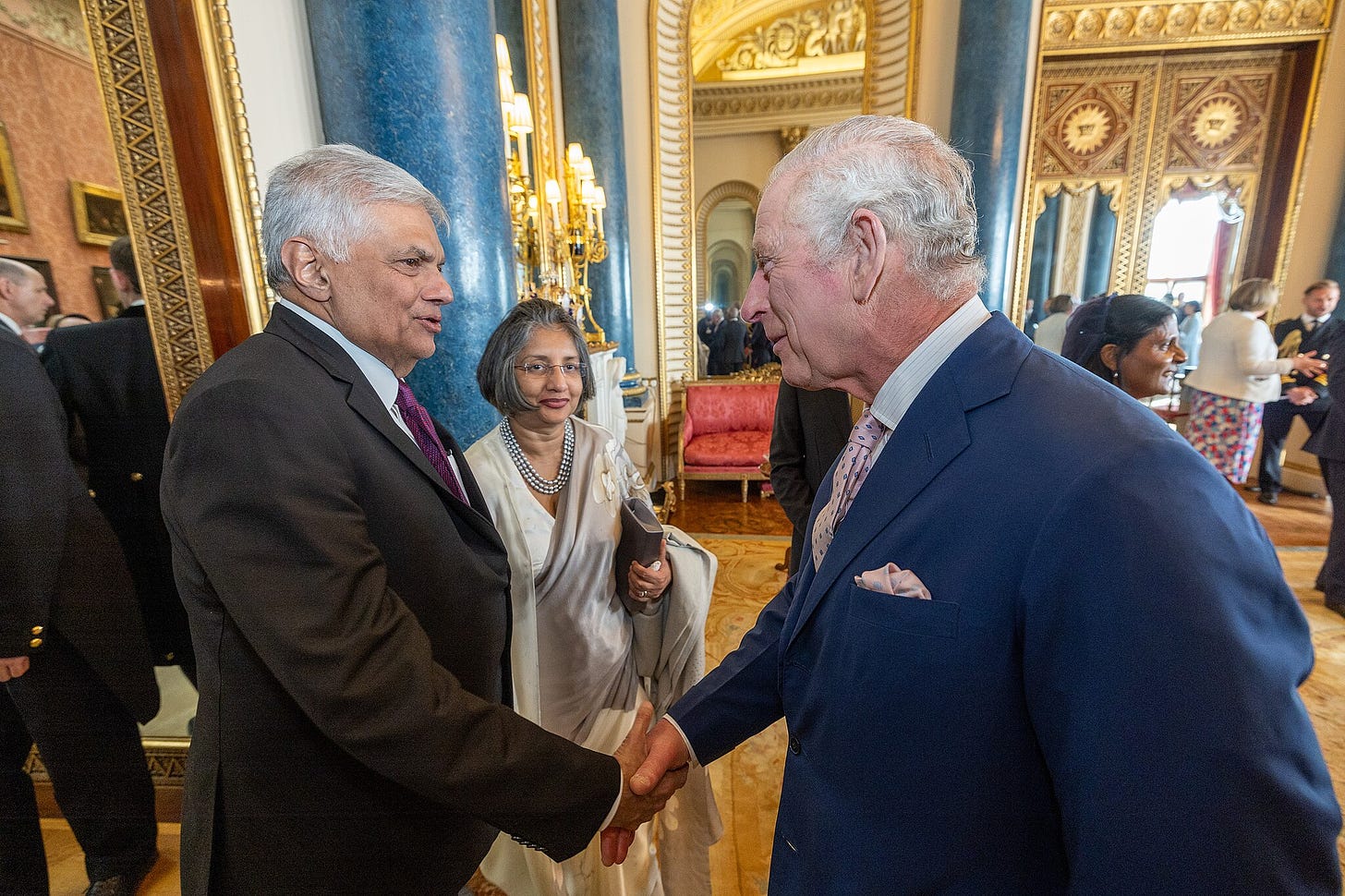Almost 15 years after end of nation’s bloody civil war, still no answers as to what happened to ‘the disappeared’
by Andrew Bunscombe, NewsReel Substack, July 11, 2023

Prof Niriella Chandrasiri investigating mass grave site at Chemmani in 1999. Image courtesy: The International Truth and Justice Project
Sometimes as a journalist you feel you’ve done a pretty good job.
You may be covering a murder trial, you may be watching a pet contest. But you come away feeling while you may have not addressed every conceivable angle, you’ve made a decent show.
Other times it’s harder. If it’s a moving story – a train crash, or mass shooting that has multiple parts, say – you have to really scramble to cover the bases.
Then there are occasions when, even as you start your work, you understand you are never going to do more than scrape the surface in the most cursory way.
The issue is so complex, so freighted with history, and there are so many powerful people trying to prevent you from getting to the truth, you almost feel tempted to not even try.
For me, the civil war in Sri Lanka that killed up to 100,000 people was one such instance. The conflict’s most recent origins date back to the 1970s when there were many different combatants, and atrocities were committed by all sides. You needed a flow chart and a timeline just to grasp the basics.
My brief involvement came at the conflict’s bloody end. By 2009, the remnants of the once powerful Tamil insurgency, had been reduced to a few remote patches of territory, and the powerful Sinhala-led government did every thing it could to prevent journalists getting anywhere close.
It also went out of its way to prevent us learning what was happening in the war zone.
We tried, but we largely failed to do our jobs.
Huge credit then to those who did not give up trying to shine a light on what happened.
A new report by a group of activists calls on the government to give answers to those who lost loved ones. These are the families of the “disappeared,” whose husbands, wives, children and grandparents were most likely buried in the countless mass graves scattered across the island.
The report – “Mass graves and failed exhumations in Sri Lanka” – calls on the government to seriously investigate the sites, identify who is buried there, and inform any relatives still alive.
It highlights numerous ways in which efforts to investigate the killings were blocked by the authorities. It also argues that with many of the relatives now elderly, officials are trying to play for time and hope they die before accountability is secured.
“After three decades and twenty attempted exhumations, only a handful of bodies have ever been identified and returned to families,” says Brito Fernando of Families of the Disappeared, one of groups who produced the report.
“We all know tens of thousands of bodies lie in shallow graves all over the island, so we can’t describe this dismal rate of progress as bad luck – it’s a clear lack of political will.”
The report’s publication coincides with the release of a powerful documentary, In Plain Sight – Searching for Truth Behind Sri Lanka’s Mass Graves, by Ruvin De Silva, that starts by asking the question – what is a “mass grave”?
For some, it is the suspected final resting place of a husband or son they last saw 40 years ago. A human rights lawyer suggests a mass grave represents the abject failure of the state to perform its most basic function – to serve the people.
A psychiatrist who is interviewed points out mass graves also mean uncertainty for families.
If a person is presented with a loved one’s remains and can identify them and hold a burial, it marks a point on the process of grief and being able to live, however painfully, with what has happened.
If someone is not presented with that proof, it never lets them move forward. They are left thinking about what happened.
Bashana Abeywardane is a Sri Lankan journalist who left in 2006 and went into exile. He now lives in Europe and is part of the group Journalists for Democracy in Sri Lanka.
The group co-authored the report which lists the failures concerning 20 exhumations, including the mass graves investigated at Matale in the centre of the country in 2012-2013 and in Mannar in the far north in 2013 and again in 2018.
More than 550 bodies have been exhumed. To date, not one has been identified. “We are good at burying in this country but not at unearthing the truth,” Bashana writes.
He told me that while various communities engaged in violence, he held the state most responsible, regardless of which political party was in charge at the time.
“We can’t overlook the fact the state has been the prime perpetrator because all these conflicts emanated from existing structural inequalities,” he said.

The UN estimated up to 100,000 people were killed in Sri Lanka’s civil war. Image: Courtesy Wikicommons
While it was true all sides committed violence, he said: “We can’t put all of them at equal footing.”
Bashana, 50, added: “The state has a primary responsibility and obligation to make sure they think equally and basically respect the fundamental rights of the people.”
I asked what gave him the energy to keep up the fight for accountability.
He said time was running out. The authorities would far rather continue to ignore this, aware that many of the loved ones killed decades ago are getting on in age. When they die, who will be left to demand answers?
He believes for any probe to have legitimacy, it would need be led by the Sri Lankan authorities, but with international partners.
“It cannot be delayed anymore,” he said.
The filmmaker, Da Silva, 36, said he hoped his film, written by Sakina Aliakbar and narrated by Aziza Esufully,“brings about positive changes for the families of the disappeared.”
“It’s crucial the younger generation is aware of the atrocities committed by both militant groups and the state,” he said.
“I believe we have to learn from and acknowledge our recent past, what our country has endured, [and] the harm we have caused to one another.”
I was among a group of journalists in the region who flew to Sri Lanka in the spring on 2009. Some international correspondents were based there, doing heroic work amid an “anti-media” mood drummed up by the authorities.
Often overlooked were the countless Sri Lankan journalists putting their lives in great danger.
One famous journalist, Lasantha Wickrematunge, had been murdered in January, having predicted his killing in an astonishing account he wrote that was published after his death.
Lasantha, editor of The Sunday Leader, one of the few independent outlets, was shot on his way to work, a few days he was due to give evidence in a corruption case about the powerful Defence Secretary Gotabaya Rajapaksa.
“No other profession calls on its practitioners to lay down their lives for their art save the armed forces and, in Sri Lanka, journalism,” his article said.
At that time, the nation was headed by President Mahinda Rajapaksa, with Gotabaya wielding perhaps even more power. Several years earlier, they had decided to retake the fight to the Tamil rebels, known as the LTTE (Liberation Tigers of Tamil Eelam) after the breakdown of peace talks.
The plan was to first retake the Tamil strongholds in the east and then move on the north.

President Ranil Wickremesinghe attended coronation of King Charles III in may 2023. Image: Courtesy of Wikicommons
By 2009, the war was in its final days. The LTTE was holed up in a few patches of territory. The ever-shrinking force of LTTE troops had taken with them many thousands of civilians; the government claimed they had been taken as human shields.
It was clear that both sides were breaking international laws of conflict, with the government shelling and bombing schools, clinics and evacuation centres. The LTTE continued to force child soldiers to the frontline.
It was a massive story, but one that was hard as hell to tell. The government refused all access, cut communications, and made claims that could never be checked. A few of us were escorted to visit sanitised camps where the civilians had been taken, but it was impossible for those people to honestly tell us what had befallen them, especially given that any interviews took place in the presence of the soldiers.
In the end, the final LTTE forces were overrun, and its leader Velupillai Prabhakaran, and some of his family were killed on May 18. A day later, the Sri Lankan government declared victory and held a victory march.
Some snippets of information did get published. We were able to confirm a number of senior Tamil leaders were killed as they tried to surrender, having been told to give themselves up and hold up a white flag.
Video would later emerge of atrocities carried out by Sri Lankan forces. The commander of the armed forces, Sarath Fonseka, would be arrested when he planned a political career and threatened to speak out about what had happened in the final days on the war.
There were various demands for an investigation from the EU, the UN, and Amnesty international. But the world quickly moved on from the horrors. Indeed, in some Western circles, the Rajapaksas were feted for their ability to rout out “terrorists”.
Much has changed in Sri Lanka in the last few years. Last year, Gotabaya Rajapaksa resigned from the presidency – a position he inherited from his brother – and fled. He did so amid widespread demonstrations about his handling of the economy, soaring food prices and devastating shortages of fuel.
But not everything represents a new broom; instead, some relatives believe it’s a return to business as usual. Ranil Wickremesinghe, of the United National Party, who was sworn in as president in the summer of 2022 had served as prime minister on six occasions.
He first entered Parliament in 1977 and soon became the country’s youngest cabinet member. A decade later, he was forced to give testimony over an alleged government-run torture centre at Batalanda, outside of Colombo. It was reportedly involved in counter-insurgency operations against the JVP, an armed group made up of Sinahala leftists.
The mass grave discovered at Matale in 2013 is believed to contain the remains of some of the JVP rebels “disappeared” by the state.
He has announced plans to hold a South Africa-style truth and reconciliation process.
The president’s office did not respond to my questions. But in an interview with France 24, Wickremesinghe, 74, said: “There will have to be a lot of been a foreign observers, independent observers.”
Several victims’ groups have questioned his plans, saying Wickremesinghe’s refusal to accept international proposals for the process showed he wanted to “follow the beaten path of not delivering justice for years of state crime”.
The groups have written to the UN Human Rights Council to urge its members to press the Sri Lankan leader.
The mass graves’ report also points out that earlier this year the UN wrote to Wickremesinghe, asking what had been done to investigate various atrocities. There was no reply.
Yasmin Sooka led the International Truth and Justice Project in South Africa and was part of a UN probe in Sri Lanka.
“Documenting the crimes, collecting the evidence and preserving it is just the first step,” she says in the report. “Thirty years later we still find ourselves fighting for truth and justice; without which the guarantee of non-recurrence remains elusive.”